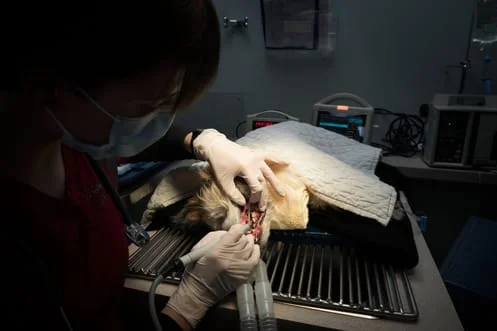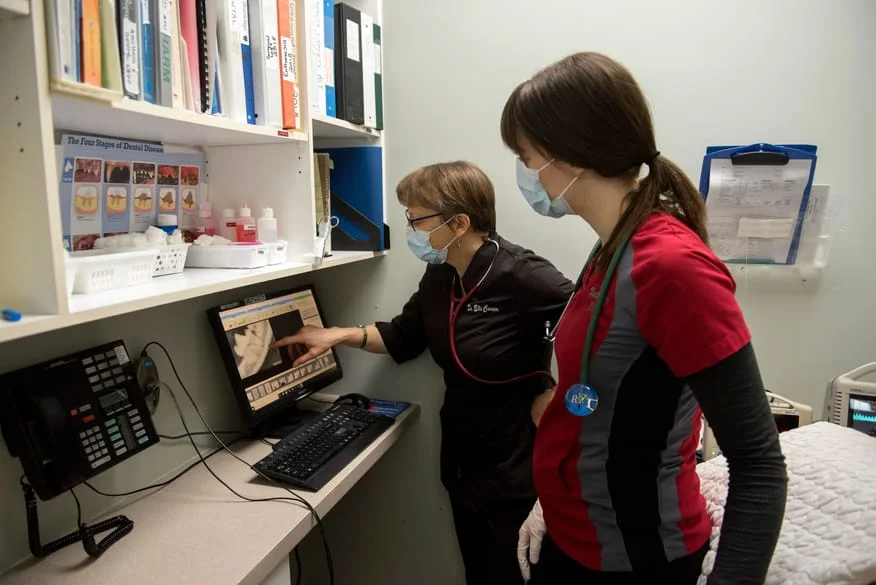
What is periodontal disease?
Periodontal disease is inflammation or infection of the gums and supporting tissues (ligaments and bones) surrounding the teeth. According to the American Veterinary Dental College, "by three years of age, most dogs and cats have some evidence of periodontal disease."
The first stage of periodontal disease is gingivitis, which is inflammation of the gums caused by plaque bacteria. The good news is that gingivitis is reversible if treated early. When gingivitis is not treated, it can lead to the later stage of the disease, called periodontitis. Periodontitis occurs when the ligaments and bones that support the tooth become inflamed or infected. Progression of periodontitis results in loss of attachment of the tooth from the supporting structures, and unfortunately the only treatment is to remove the tooth.
What are some signs and symptoms of periodontal disease?
One of the most frustrating things about dental disease is that our pets often do not show signs of discomfort or pain. However, some of the signs and symptoms below might be observed:
- Inappetence
- Halitosis (a.k.a. bad breath)
- Head shaking
- Pawing at mouth
- Excessive drooling
- Reluctance to “mouth” toys
- Dropping food (food apprehension difficulty)
Comprehensive Oral Health Assessment and Treatment (COHAT):
A comprehensive oral health assessment and treatment (or “COHAT”) involves cleaning and polishing your pet’s teeth, taking dental radiographs (x-rays), a full intra oral exam where each tooth and the surrounding tissue is inspected for any abnormalities, and any treatment that is recommended including the surgical extraction of teeth. This procedure is performed while your pet is under general anesthesia, being closely monitored by both the RVT (Registered Veterinary Technician) and Veterinarian.
There are many reasons why we may recommend a COHAT for your pet, such as tartar accumulation, inflammation of the gum tissue, a fractured tooth, or resorptive lesion noted on their oral exam. One of the most important reasons for this recommendation is that oral health issues have the potential to affect the whole body; periodontal disease is a risk factor for liver, heart, and kidney disease as bacteria can travel from inside the mouth into the bloodstream and circulate through the body. By performing regular COHATs, we can prevent more advanced periodontal disease and help improve your pet’s overall health, too.

Dental radiographs, what’s that?
Dental radiographs are x-rays taken of your pet’s teeth. Along with examining and probing each tooth, dental radiographs are an essential part of your pet’s dental procedure as over 50% of each tooth is below the gum line - just like icebergs! Radiographs allow the veterinarian to assess the roots and surrounding bone structure of each tooth, so that we are able to provide the most appropriate and comprehensive treatment plan while your pet is here! Our dental suite is outfitted with digital dental x ray machine to best serve your pet. We recommend every pet coming in for a COHAT have full mouth radiographs performed.
How to care for your pets teeth at home:
The best way to prevent or delay the onset of periodontal disease is to brush your pet’s teeth every day! Just like in humans, plaque bacteria start to accumulate on teeth within hours of cleaning them. Our RVTs are happy to show you how to introduce tooth brushing to your cat or dog at their next visit.
There are also dental health diets for both cats and dogs available by Royal Canin, Hills, and Purina Veterinary Diets. These diets are clinically proven to slow tartar build up when fed as directed, and can be a great addition to your home care routine. Ultimately though, even with homecare like tooth brushing, our pets will need regular professional dental cleaning throughout their lives, just like humans do.
What to Expect:
Have you scheduled your pet for their dental procedure, and now you’re wondering what comes next? One to two weeks prior to their COHAT, your pet will come in for a pre operative exam. During this appointment, we will collect a blood sample to run a pre anesthetic blood panel to assess blood cell counts and organ function, to ensure they are a good candidate for general anesthesia. During this appointment, we will also prescribe your pet an oral sedative that you will give at home the night before and/or morning of their procedure. This oral sedation aims to reduce stress when being admitted into the hospital, and is an important part of our anesthetic protocol.
We will ask that you bring your pet to the clinic the morning of their procedure typically between 8:15am - 8:45am. Your pet will need to be fasted with no food for 12 hours, and no water for 2 hours prior to coming in.
Your pet will receive a sedative injection and we will place an intravenous catheter in their front leg to deliver medications and fluid therapy to keep them well hydrated. They will then be put under general anesthesia, and the COHAT will begin. The veterinarian will contact you should anything unexpected arise after the oral exam and x-rays are completed.
Once the cleaning, polishing, and any additional treatments (such as tooth extractions) are complete, your pet will be woken up from general anesthesia, and will continue to be monitored closely for the next couple of hours, until they are discharged to you in the late afternoon. The RVT will review all the homecare instructions, medications, and recheck exams before your pet goes home.


